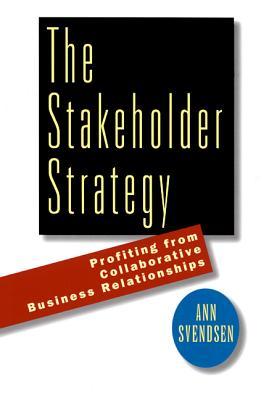
Zustellung: Sa, 09.08. - Fr, 15.08.
Versand in 3-4 Wochen
VersandkostenfreiIn today's highly networked and competitive global economy, mounting social and environmental problems are forcing corporations to focus on more than just their stockholders' interest in meeting bottom line profitability. More and more companies are recognizing the value of identifying and building relationships with all of their organization's stakeholders-employees, customers, suppliers, and even communities. In fact, recent research has shown that companies that treat their employees well, create jobs in the local economy, develop innovative products and services, take care of the environment, and contribute to the community, are often more profitable.
In The Stakeholder Strategy, sociologist Ann Svendsen presents an effective and practical step-by-step guide that companies can use to forge a network of powerful and profitable collaborative stakeholder relationships.
While some forward-thinking corporations have tried limited collaborative approaches-focusing on one stakeholder group at a time-few have taken a comprehensive and strategic approach to building relationships with all of their stakeholders, notes Svendsen. And, while considerable commitment to the idea of stakeholder collaboration exists, there is a lack of knowledge and understanding about how to develop these relationships. The Stakeholder Strategy is the first book to show business leaders and managers how to establish and maintain positive, mutually beneficial stakeholder relationships. Based on a synthesis of ideas from community relations, corporate philanthropy, stakeholder management, organizational change, sustainability, and the corporate social responsibility literature, it offers an integrated framework, as well as the practical tools for developing new kinds of collaborative relationships.
Svendsen uses easy-to-grasp concepts from everyday life, such as the process we go through in finding a mate or developing a long-term friendship, to illustrate these relationship-building strategies. She lays out the steps a company should take to create a collaboration-friendly organization: establishing a social mission, values, and ethical guidelines; assessing corporate readiness for collaboration; and making changes in communication, information and reward systems to support internal and external collaboration. Featuring case study examples from companies in North America and Europe who are working to build collaborative relationships with their stakeholders, The Stakeholder Strategy is the first book to provide a detailed explanation of how to conduct stakeholder audits and social audits so that companines can evaluate their relationship-building success and keep on track.
In The Stakeholder Strategy, sociologist Ann Svendsen presents an effective and practical step-by-step guide that companies can use to forge a network of powerful and profitable collaborative stakeholder relationships.
While some forward-thinking corporations have tried limited collaborative approaches-focusing on one stakeholder group at a time-few have taken a comprehensive and strategic approach to building relationships with all of their stakeholders, notes Svendsen. And, while considerable commitment to the idea of stakeholder collaboration exists, there is a lack of knowledge and understanding about how to develop these relationships. The Stakeholder Strategy is the first book to show business leaders and managers how to establish and maintain positive, mutually beneficial stakeholder relationships. Based on a synthesis of ideas from community relations, corporate philanthropy, stakeholder management, organizational change, sustainability, and the corporate social responsibility literature, it offers an integrated framework, as well as the practical tools for developing new kinds of collaborative relationships.
Svendsen uses easy-to-grasp concepts from everyday life, such as the process we go through in finding a mate or developing a long-term friendship, to illustrate these relationship-building strategies. She lays out the steps a company should take to create a collaboration-friendly organization: establishing a social mission, values, and ethical guidelines; assessing corporate readiness for collaboration; and making changes in communication, information and reward systems to support internal and external collaboration. Featuring case study examples from companies in North America and Europe who are working to build collaborative relationships with their stakeholders, The Stakeholder Strategy is the first book to provide a detailed explanation of how to conduct stakeholder audits and social audits so that companines can evaluate their relationship-building success and keep on track.
Inhaltsverzeichnis
Chapter 1. Why Build Collaborative Stakeholder Relationships?
Chapter 2. Stakeholder Collaboration and the Bottom Line
Chapter 3. A New Framework for Corporate-Stakeholder Relations
Chapter 4. Six Steps to Building Collaborative Relationships
Chapter 5. Corporate Mission, Values and Ethics--A Foundation for Relationship-
Building
Chapter 6. Preparing a Relationship Building Strategy
Chapter 7. Aligning Corporate Systems and Structures
Chapter 8. Forming a Collaborative Group--From Courtship to Marriage
Chapter 9. Collaborative Mind and the Power of Long Term Relationships
Chapter 10. Social Accounting--Assessing Corporate Social Performance
Chapter 11. Stakeholder Audits--A Practical Guide to Assessing Stakeholder Relationships
Chapter 2. Stakeholder Collaboration and the Bottom Line
Chapter 3. A New Framework for Corporate-Stakeholder Relations
Chapter 4. Six Steps to Building Collaborative Relationships
Chapter 5. Corporate Mission, Values and Ethics--A Foundation for Relationship-
Building
Chapter 6. Preparing a Relationship Building Strategy
Chapter 7. Aligning Corporate Systems and Structures
Chapter 8. Forming a Collaborative Group--From Courtship to Marriage
Chapter 9. Collaborative Mind and the Power of Long Term Relationships
Chapter 10. Social Accounting--Assessing Corporate Social Performance
Chapter 11. Stakeholder Audits--A Practical Guide to Assessing Stakeholder Relationships
Produktdetails
Erscheinungsdatum
05. November 1998
Sprache
englisch
Seitenanzahl
224
Autor/Autorin
Ann Svendsen
Verlag/Hersteller
Produktart
gebunden
Gewicht
508 g
Größe (L/B/H)
243/164/21 mm
ISBN
9781576750476
Entdecken Sie mehr
Bewertungen
0 Bewertungen
Es wurden noch keine Bewertungen abgegeben. Schreiben Sie die erste Bewertung zu "The Stakeholder Strategy" und helfen Sie damit anderen bei der Kaufentscheidung.








